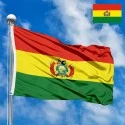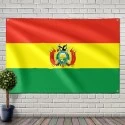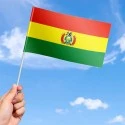The flag of Bolivia is a vibrant tricolor that serves as a profound symbol of the country's history, natural riches, and national spirit. Composed of horizontal stripes of red, yellow, and green, it is an embodiment of the memory of the struggle for independence, pride in mineral resources, and hope for the future. The official state flag, used by the government and military, also includes the intricate national Coat of Arms, adding another layer of historical and cultural symbolism.
A Detailed Look at the Flag's Design and Symbolism
The national flag of Bolivia, also known as the civil ensign, is a simple but powerful horizontal tricolor of red, yellow, and green stripes of equal width. The state and war flag, however, features the national Coat of Arms prominently in the center of the yellow stripe.
Each of the flag's colors carries a specific and profound meaning:
-
Red: The top stripe of red symbolizes the blood shed by the national heroes who fought for the birth and preservation of the Republic of Bolivia. It is a tribute to the sacrifices made by patriots in the long struggle for independence from Spanish colonial rule.
-
Yellow: The middle stripe of yellow represents the nation's vast mineral wealth and natural resources, particularly the gold and silver of its mines. It is a symbol of economic prosperity and the potential for a bright future.
-
Green: The bottom stripe of green symbolizes the country's hope, rich biodiversity, and natural environment. It represents the lush forests, agricultural lands, and the nation's enduring commitment to its natural heritage.
The Coat of Arms, a central feature of the state flag, is a complex and deeply symbolic emblem:
-
The central oval shield depicts the mountain of Potosí, a symbol of Bolivia's mineral wealth. In front of it is a llama, representing the country's fauna, alongside a breadfruit tree and a wheat sheaf, symbolizing its rich flora and agriculture.
-
The shield is surrounded by ten stars, one for each of Bolivia's nine departments and the former coastal province of Litoral (now part of Chile), which was lost in the War of the Pacific.
-
The shield is flanked by two crossed cannons, two pairs of muskets, an axe, and a Phrygian cap on a shield, which are also part of the state flag's design.
-
Above the shield, an Andean condor, the national bird, soars with a laurel and an olive branch in its beak, symbolizing freedom, glory, and peace.
The History and Creation of the Flag
The history of the Bolivian flag is marked by several changes since the nation declared its independence. The first flag was adopted in 1825 and featured green, red, and green stripes. This was quickly replaced in 1826 with a tricolor of red, yellow, and green, a design that has largely remained since.
The current version of the flag, with its specific color order (red, yellow, green), was officially adopted on October 31, 1851. This design solidified the colors and their symbolic meanings. The use of the Coat of Arms was officially incorporated into the state flag on July 25, 1826, and its specific design has been refined over the years, though the core elements have remained consistent.
A significant recent development in the country's vexillological identity is the official recognition of the Wiphala as a co-official national symbol. The Wiphala is a square, checkered flag representing the indigenous peoples of the Andes. Its official status was established by the new Constitution in 2009, signifying a deeper recognition of Bolivia's multicultural identity and indigenous heritage. This dual-flag system is unique and powerful, representing both the modern republic and its ancient roots.
Meaning and Significance for Residents
For the people of Bolivia, the flag is a cherished symbol of their collective history, resilience, and identity. The colors are not just aesthetic; they are a constant reminder of the nation's sacrifices for freedom, its abundant natural resources, and its hopes for a prosperous future. The Coat of Arms on the state flag is a detailed narrative of the country's geography, fauna, flora, and historical aspirations. The inclusion of the Wiphala as a co-official flag is a particularly important and unifying gesture for the nation's large indigenous population. It symbolizes respect for their history and a commitment to building a more inclusive and equitable society. The flag is proudly displayed during national holidays like Independence Day (August 6th), serving as a powerful and unifying emblem for all Bolivians.
Interesting Facts
-
The national flag of Bolivia has two main versions: the civil flag (or civil ensign), which is the simple red-yellow-green tricolor, and the state flag, which includes the Coat of Arms. Private citizens typically fly the civil flag.
-
The Wiphala, a checkered flag representing the indigenous peoples of the Andes, was officially recognized as a national symbol in the 2009 Constitution, making Bolivia one of the few countries with two official national flags.
-
The Coat of Arms features a unique mix of symbols, including an Andean condor, a llama, and the mountain of Potosí, which was once one of the most important silver mines in the world.
-
The ten stars on the Coat of Arms include a star for the Litoral province, which was lost to Chile in the War of the Pacific. This inclusion is a symbol of Bolivia's historical claim to a sovereign sea outlet.
-
The flag is so revered that there is a Flag Day in Bolivia (August 17th), which is a national holiday dedicated to honoring the flag and its symbolism.
In the demonstration images, full-size flags are shown with proportions of 2:3, and hand-held flags with proportions of 1:2.








 Waving flag
Waving flag
 Sizes:
Sizes:
 Round flag
Round flag
 Sizes:
Sizes:
 Rectangular flag 2:3
Rectangular flag 2:3
 Sizes:
Sizes: